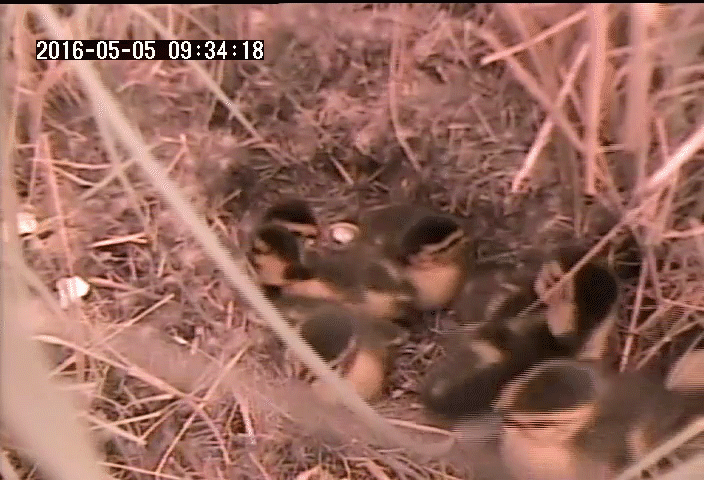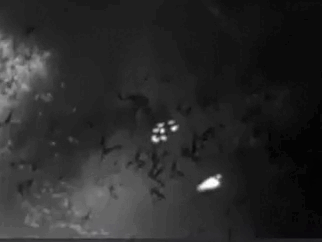6 Migratory Birds USGS is Following
You might follow a lot of accounts on Twitter or Instagram, but at the USGS we follow the birds. With the help of lightweight GPS-transmitters to track migratory birds in near real-time and classic tools like bird bands, we study the flight paths and behaviors of birds all over the world. For World Migratory Bird Day on May 14, here are six of our favorites.
1. Where The Ducks Go: Cinnamon Teal
The Cinnamon Teal is a handsome dabbling duck found across Western North and South America. Like other waterfowl species, it relies on networks of wetlands across the west, migrating between breeding and wintering grounds. Though cinnamon teal are common today, their reliance on wetlands may put them at risk of drought, changes in land or water management, or changing climate. Fall-migrating cinnamon teal must pass through the dry southwestern United States, where many historical wetlands have been lost and water is limited. Many of the wetlands cinnamon teal depend on are small, only temporarily flooded, or depend on intensive management by people. Understanding the migratory patterns and habitat use of cinnamon teal can help managers support these birds and other waterfowl in the region.
Since 2017, USGS scientists have tagged more than 200 cinnamon teal with lightweight, solar-powered GPS-GSM transmitters, which the ducks wear like backpacks. The GPS transmitters produce near real-time data on where the birds go and what kinds of habitats they use.
We have learned these ducks use many kinds of wetlands as stopover sites during their migration, from natural wetlands to wastewater ponds and ponds in golf courses. The most used stopover habitat type was wet agriculture, which included stock ponds, small impoundments, irrigated ditches, and flooded fields. These results highlight how Cinnamon Teal and other dabbling ducks have benefitted from agricultural practices even as other wetlands have been lost across the West. Another USGS study focused on Cinnamon Teal and other waterfowl wintering in the California Central Valley and other parts of the West showed they often visited bodies of water and agriculture near poultry and cattle facilities, demonstrating the potential risk of introducing avian influenza virus to domestic livestock.
2. By Land and By Sea: Pink-Footed Shearwater
Ducks and geese might be the poster birds for migration, but when it comes to distance, seabirds take the prize. Many species travel between hemispheres each year. One such trans-equatorial migrant is the Pink-footed Shearwater, a relative of petrels and albatrosses.
The Pink-footed Shearwater’s small breeding range puts it at risk, and it is listed as Vulnerable by the IUCN and Endangered in Chile and Canada. USGS scientists and collaborators have been tracking Pink-footed Shearwaters with satellite transmitters since 2006, revealing the migration patterns shown in the graphic below. While the Pink-footed Shearwater can be found off the Pacific Coast up to Alaska during our summertime, it nests only on three islands off the coast of Chile, during the Southern Hemisphere's summer. Even though they roam widely the rest of the year, those islands are critical to the pink-footed shearwater’s survival. Tracking the Pink-footed Shearwater has allowed researchers to identify potential threats to the species in different parts of their range.
Conserving migratory bird populations can be a challenge because they rely on different habitats during different parts of their life cycles. These areas may be far apart and managed by different countries, with different challenges for the birds to navigate. For example, USGS researchers have found that breeding Pink-footed Shearwaters overlapped extensively with industrial and artisanal purse-seine fisheries in Chile, a potential bycatch risk. Along the California coast, the Pink-footed Shearwater is one of many seabird species whose satellite-transmitter-derived flight patterns are being used to inform offshore wind energy planning.
3. Through Smoky Skies: the Tule Goose
One of the main features of bird migration is its remarkable consistency: birds follow the same routes and visit the same places year after year after year. So what happens when something throws a migratory bird off course?
In September 2020, four GPS-marked Tule Geese were flying through the Pacific Northwest in the first part of their migration when they ran into smoky skies. Matching the GPS tracks with a 3D model of the smoke, the researchers determined that the geese took twice as long to reach their destination and used more energy as they altered their paths or paused their flights to avoid wildfire smoke.
The results indicate that smoke from larger wildfires and longer wildfire seasons may increasingly disrupt migration for Pacific Flyway birds into the future.
4. A Needle in a Haystack: Southwestern Willow Flycatcher
While the migratory paths of many larger birds like waterfowl and seabirds are now well-understood, very little is known about where the rare, tiny Southwestern Willow Flycatcher spends the winter. This songbird is too small to attach transmitters to track migratory routes, so scientists rely on re-sighting individually color banded birds to identify their breeding and wintering grounds. That is easier said than done. Museum specimens and genetic studies have helped narrow the search area, but given the rarity of the species, the number that have been banded, spotting one in its wintering grounds is exceedingly rare.
That’s why USGS ecologist Barb Kus, was so thrilled in early 2020 when one of the birds her team banded in Southern California three years earlier was spotted 3,000 miles away in Nicaragua. "It's the true needle in the haystack!” said Kus at the time.
That sighting provided the first evidence connecting San Diego County populations to a wintering site in Nicaragua. This information will benefit the species at both ends of its geographic range and inform conservation efforts.
5. Smile, You’re on Duckling Camera: Gadwall ducklings
While many USGS researchers study the large-scale behavior of migratory birds, others are focused on a much smaller scale. Before migratory birds ever take to the skies, they have to hatch and leave their nests. In these early days, USGS scientists use different tools to follow bird behavior.
These adorable Gadwall ducklings were caught on a wildlife camera at a nest in Suisun Marsh, California. The cameras allow USGS scientists to observe all parts of the nesting process: how often the hens leave the nests, whether predators like racoons and skunks visit the nest, when the eggs hatch, and when the ducklings depart the nest to head out into the wetland for the first time. If you look carefully, you can see in the nest a circular device called an iButton™, which records nest temperature during the incubation period. These temperature records can be used to determine when hens leave the nest or are killed by predators—hens keep the nest toasty when they are sitting on the eggs, and the temperature drops when they leave.
Once ducklings leave the nest, USGS scientists attach tiny, lightweight VHS-transmitters to some ducklings’ backs to follow them. These transmitters emit a signal that can be detected on the ground not far from the tagged animals, so scientists can track them down as they move around the marsh. These transmitters fall off as the ducklings grow. In recent years, USGS researchers have been developing techniques for using thermal cameras mounted on drones to locate nests and ducklings from the air. These techniques could enhance detection, estimation, and monitoring of waterfowl broods in flooded habitats.
6. What’s on the Pre-Migration Menu?: Western Sandpiper
The Western Sandpiper is a small shorebird that weighs a little less than a slice of bread. During the winter, Western Sandpipers forage on mudflats all along the Pacific Coast from British Columbia to Peru. In the spring, western sandpipers migrate north to their breeding area in Alaska. That is a long way for these little birds to travel, and these migratory flights require lots of energy!
Because flight is so energy-intensive, studying what birds eat is an important part of following migratory bird behavior. How can you tell what a bird is eating? Well, you can watch them eat, or you can look at what’s in their guts. But there’s a less time consuming, less invasive strategy that the USGS scientists have used to learn what western sandpipers eat to fuel up for their journeys.
The approach they used is called stable isotope analysis. Scientists use carbon and nitrogen isotopes to study animal diets. Isotopes are simply varied forms of the elements found in nature. Different types of plants, animals, or microorganisms have different ratios of carbon and nitrogen isotopes in their bodies because of the foods they eat or the way their bodies work. When a sandpiper feeds, the carbon and nitrogen in their food becomes carbon and nitrogen in their bodies, and the isotope ratios in their food can now be detected in the sandpiper. As a result, the isotope ratios in western sandpiper blood can provide hints to what they have eaten.
Using this method, USGS scientists found that Western Sandpipers sampled in San Francisco Bay had different diets depending on the time of year. In the winter, birds of different ages and sexes ate mostly the same thing. Just before their spring migration, the sandpipers began to specialize: long-billed adult females ate more marine worms and short-billed juveniles ate energy-rich biofilm. Like an athlete eating a big pasta dinner before a big game, the sandpipers fueled up on food that was easy to eat and give them lots of energy.













